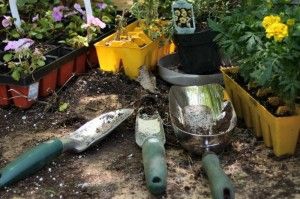Are you worried that that office plant is going to wilt over the winter season? Every year, plenty of property owners attempt to brighten up their space with houseplants, only to have them die off over the holiday season. The good news is that in California, there is usually more sun and less cold, which creates a better environment for your plants. The bad news is the drop in temperatures and change in seasons can still affect your indoor greenery. Fortunately, with a few simple adjustments to the care you are providing, your houseplants can survive longer than you even imagined. Keep reading to learn how to keep your houseplants looking great this winter, and make sure to hire our Southern California commercial landscaping pros at Stay Green Inc. to keep your outdoor plants looking great, too.
7 Tips to Help Your Houseplants Survive Through Winter:
- Don’t Over-Water: Although you may be tempted to provide your plants with more water over winter to offset the change in seasons, doing the opposite is actually better for them. Plants grow slower in the winter, so they need less water. The average fern, for instance, should only be watered when the soil around it is almost dry. A cactus, on the other hand, needs consistently dry soil, and should only be watered once the soil is completely devoid of moisture.
- Adjust Temperatures Accordingly: With summer well behind us, you probably have no interest in going back to humid temperatures of the past few months. Yet the reality is that houseplants need a slightly higher level of humidity to survive. Obviously, you don’t want to have to crank up the heater, so to help with this you can run a humidifier, and place plants in rooms that are more humid. Placing a tray of water near your plants can also help, along with putting multiple plants close together. In addition, you’ll want to keep the climate in your space as consistent as possible, as letting the temperature dip below 50 degrees on a cold winter night can kill a plant quickly. You may even want to avoid putting plants near windows, which, despite being a source of sunlight, are often quite chilly in the winter.
- Get Rid of Pests: If you are bringing plants in from outside make sure to thoroughly check them for pests. Bugs will often try to stow away with indoor plants for the winter, which is obviously bad for your office or other space, but is also not good for your plants. Even if you got your plant from a reputable seller, check for pests, since as soon as you see them in one plant, there is a greater chance they have spread to another one, too.
- Avoid Repotting: Although this may be difficult if you are bringing in plants from outside, it’s best to avoid repotting your plants if at all possible. Being repotted can put a lot of stress on a plant, and because they are more dormant in winter anyway, they often have a hard time recovering from this process.
- Dust Thoroughly: Not only does dust look bad on plants, it can prevent them from absorbing the sunlight they need to grow, too. This in turn can cause your plants to become diseased. Try to dust your plants and lightly wash leaves with water once a month to prevent this from happening.
- Toss the Fertilizer: Plants need to be fertilized in spring and summer to help them grow. However, winter is a growing off-season for plants, so you should toss the fertilizer away for the season.
- Use Different Lighting: While plants need sunlight to grow, there is less sun to be had in the winter, and as we’ve already discussed, putting houseplants near windows can actually hurt them during the winter. Because of this, you may want to consider an alternative light source, such as fluorescent growth lights, or incandescent lighting. It may not always be easy to find a place to put these lights, but by placing them just 6-12 inches above your houseplants, you can help your plants stay healthy all winter long. These lights are a solid investment from year to year, and some growth lights even change colors to tell you how much heat your plants’ need.
For more information on houseplants or general landscaping tips, dial (800) 741-9150 now, or click here to request service from our Southern California landscaping team online.

